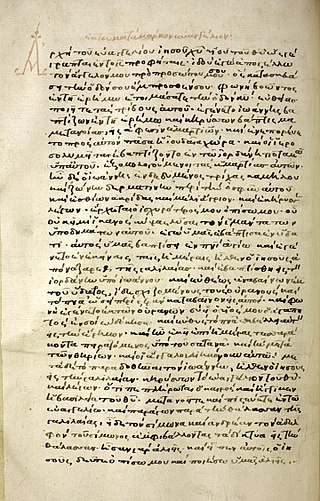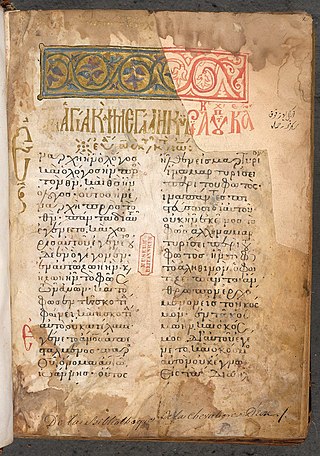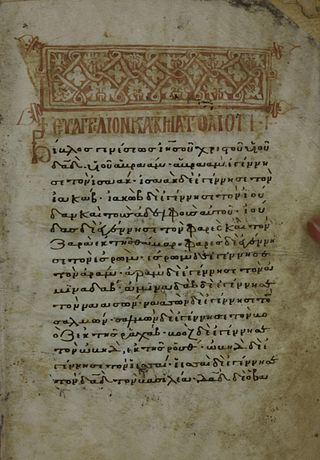
Codex Regius, designated by siglum Le or 019, ε56, is a Greek uncial manuscript of the New Testament written on parchment. Using the study of comparative writing styles (palaeography), it has been assigned to the 8th century. The manuscript has several gaps. Textual critic Frederick H. A. Scrivener described it as "by far the most remarkable document of its age and class."

Codex Basilensis A. N. IV. 2, known as Minuscule 1, δ 254, and formerly designated by 1eap to distinguish it from minuscule 1rK is a Greek minuscule manuscript of the entire New Testament, apart from the Book of Revelation. Using the study of comparative writings styles (palaeography), it is usually dated to the 12th century CE.

Codex Basiliensis A. N. IV. 1, known as Minuscule 2, ε 1214, is a Greek minuscule manuscript of the New Testament, written on parchment. Using the study of comparative writing styles (palaeography), it has been dated to the 11th or 12th century. The manuscript has complex contents. It is one of several Greek New Testament manuscripts housed at the Basel University Library, all of which take their name from the Latin adjective for Basel.

Minuscule 69, δ 505, known as the Codex Leicester, or Codex Leicestrensis, is a Greek minuscule manuscript of the New Testament on paper and parchment leaves. Using the study of comparative writing styles (palaeography), it has been dated to the 15th century. Some leaves of the codex are lost. It has been examined and collated by many palaeographers and textual critics. Although it is of a late date, its text is remarkable from the point of view of textual criticism.
Minuscule 28, ε 168, formerly known as Colbertinus 4705, is a Greek minuscule manuscript of the New Testament, written on vellum. Using the study of comparative writing styles (palaeography), it has been dated to the 11th-century. It contains marginal notes (marginalia), and has several gaps.
Codex Ephesinus, minuscule 71, ε 253, is a Greek minuscule manuscript of the New Testament, on parchment, illuminated, and elegantly written. It is dated by the colophon to 1160. In the 15th century the manuscript was prepared for liturgical use. The scribal errors are not numerous, but it has many textual divergences from the common text. The Greek text of the codex is a representative of the Byzantine text-type, but the textual character of the codex is disputed by scholars since the 19th century.
Minuscule 75, ε 176, known as Codex Genevensis, is a Greek minuscule manuscript of the New Testament, on parchment leaves. Palaeographically it has been assigned to the 11th century. The codex has complex contents. It was adapted for liturgical use. It has complex contents, and full marginalia.
Minuscule 94 (in the Gregory-Aland numbering), O31 (von Soden), is a Greek minuscule manuscript of the New Testament, on parchment and paper, dated to the 12th or 13th century. Formerly it was labelled by 18a, 21p, and 19r.

Minuscule 157, ε207, is a Greek minuscule manuscript of the New Testament Gospels, written on parchment. According to the colophon it is dated to the year 1122. The date had been wrongly deciphered formally as 1128. It has complex contents and full marginal notations.

Lectionary 184, designated by siglum ℓ184 is a Greek New Testament manuscript written on parchment. Textual critics Westcott and Hort referred to it by the siglum 39e, textual critic Scrivener by 259e. It is dated by a colophon to the year 1319. It is currently housed at the British Library in London.

Lectionary 183, designated by siglum ℓ183 is a Greek manuscript of the New Testament, written on parchment in uncial letters. Biblical scholars Westcott and Hort labelled it by 38e,and biblical scholar Frederick H. A. Scrivener by 257e. Using the study of comparative writings styles (palaeography), it has been assigned to the 10th century. The manuscript has some missing portions and gaps at the end and inside, but they were supplied by a later hand. It is faded in parts.
Minuscule 471, α 136, is a Greek minuscule manuscript of the New Testament, on a parchment. Palaeographically it has been assigned to the 12th century. Scrivener labelled it by number 510. The manuscript has no complex contents.
Minuscule 475, α 138, is a Greek minuscule manuscript of the New Testament, on parchment. Palaeographically it has been assigned to the 11th century. Scrivener labelled it number 515. It has full marginalia.

Minuscule 480, δ 462, is a Greek minuscule manuscript of the New Testament, on parchment. It is dated by a colophon to the year 1366. The manuscript is lacunose. The manuscript was adapted for liturgical use. It has marginalia. It contains liturgical books with hagiographies: Synaxarion and Menologion.

Minuscule 482, ε 1017, is a Greek minuscule manuscript of the New Testament, on parchment. It is dated by a colophon to the year 1285 . Scrivener labelled it by number 570. The manuscript has complex context, but faded in parts. The text exhibits more numerous and bolder textual variants than usual manuscripts of the four Gospels. Marginal apparatus is given fully.

Minuscule 537, ε 334, is a Greek minuscule manuscript of the New Testament, on a parchment. Palaeographically it has been assigned to the 12th century. Scrivener labelled it by number 550. The manuscript was prepared for liturgical use, its marginalia are not complete. It has survived until the present day in complete condition.

Minuscule 543, ε 257 and labelled 556 by biblical scholar and textual critic F. H. A. Scrivener, is a Greek minuscule manuscript of the New Testament, written on parchment. Using the study of comparative handwriting styles (palaeography) it has been assigned to the 12th century.

Minuscule 545, ε 511, is a Greek minuscule manuscript of the New Testament, on paper. It is dated by a colophon to the year 1430. Scrivener labeled it by number 558. It is housed at the University of Michigan. It has marginalia.

Minuscule 546, ε 511, is a Greek minuscule manuscript of the New Testament, on parchment. It is dated palaeographically to the 13th century. It has some marginalia, the scribe has made numerous errors.

Minuscule 699, δ104, is a Greek minuscule manuscript of the New Testament, on parchment. Palaeographically it has been assigned to the 11th century. Some leaves of the manuscript were lost. Scrivener labelled it by 603e.














